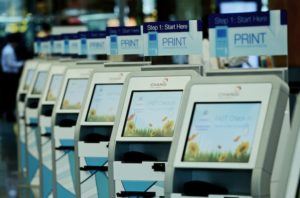The evolution of Singapore’s Changi Airport

Travelers numbers are expected to reach 4 billion by 2017. How are the biggest airline hubs in the world dealing with this rapid growth?
The new reality
Our world has become smaller and more accessible with the rapid expansion of the airline industry. Nowadays, airlines can connect 500+ people between two cities 8600 miles apart with a single nonstop 17-hour flight. These journeys have not only become more frequent but also more affordable for a higher percentage of our population resulting in an increase in number of travelers.
Total passenger numbers from 1970-2015
Travelers are expected to reach 4 billion by 2017.
http://data.worldbank.org/indicator/IS.AIR.PSGR?end=2015&start=1970&view=chart
Asia’s rapid business development has positioned the continent as the fastest growing in the world. As a result, some airports in the region are now operating over their capacity causing flight delays and constantly disrupting the service to its customers. While upgrades in infrastructure are certainly needed, the lead times for those types of constructions can be very long and expensive. Hence airports are relying on technology to find clever ways to cope with the rapid growth of the industry while achieving operational excellence. Singapore’s Changi airport, voted best airport in the world in a 2014 Skytrax survey of travelers from over 160 countries2, is a perfect example of how the right use of digitalization can yield wonderful results.
The new experience
With 148,000 passengers on a daily basis, Changi airport has implement a number of initiatives to both improve its passenger experience and maximize its productivity3.
- Fast and Seamless Travel (FAST) project: The airport is installing self-service kiosks at the check-in counters in order to reduce waiting times and improve efficiency. These kiosks can assist passengers with or without bags, helping them to check-in into the flight, select seats and print both boarding passes and bag tags4.
Self-service kiosks at Changi Airport.
http://www.silverkris.com/sites/default/files/2015/1508-kiosk-635.jpg
- Instant Feedback Systems (IFS): These automated systems installed throughout the airport (immigration, food court, bathrooms etc.) function through a simple touch screen interface allowing customers to immediately rate their experience. By implementing this, the airport collects 1.5 million responses a month and uses the feedback to improve its operations2.
Traveler rates her experience while using one of the airports bathrooms.
http://www.futuretravelexperience.com/2013/05/top-10-trends-that-will-change-air-travel-forever-part-two/
- Service Workforce Empowerment and Experience Transformation (Sweet) initiative: This project aims at improving communication among the airport’s staff. Through an Ipad application, employees can access real-time operational data and coordinate tasks with their peers without having to be near a computer. It provides versatility and control to the workforce5.
- Smart Apron Initiative: The airport plans to install a Wi-Fi network to get internet coverage in 4 different terminals. The objective of this initiative is twofold; first, provide passengers with internet access and second, improve the airport’s flow of information. Through the use of mobile devices, the airport staff will have visibility over the location of different resources such as vehicles and equipment. It is estimated that 5,000 employees will benefit from this project6.
These are only a few examples of successful projects at the Changi Airport that have allowed the airport to differentiate its services from the rest and cope with the growing number of travelers. Changi Airport has done an outstanding job since it not only focused on how to improve their customer experience but also actively invested in their staff and operations to support the process.
As the airport continues its mission of accomplishing operational excellence, there is one additional “pain-point” that I believe they should address; the security experience. The latter, tends to be one of the most time-consuming and uncomfortable for travelers. With the use of technology, airports can reach customers through their cellphones, redirecting them to security checkpoints with lower queue times (not necessarily the closest to your check-in counter). In addition, security teams should install self-service mechanisms such as fingerprint and facial recognition devices to fast-track the process during peak hours. Improving the airport security experience while protecting the welfare of the people is not an easy task. Nevertheless, there are small steps that airports can take to alleviate the friction of this process.
By integrating digital technologies to its operating model, Changi Airport has achieved the perfect combination of high productivity and extraordinary service. Its initiatives have yielded groundbreaking results allowing the airport to be rated as the best in the world for 3 years in a row. Its thrive for continuous improvements through the mechanisms that it has in place has attracted customers not only looking to fly but also non-travelers arriving to eat and shop7. (Word count: 729)
- “Airport Infrastructure in Asia – PricewaterhouseCoopers.” Airport Infrastructure in Asia Coping with the Demand Surge. N.p., n.d. Web. 17 Nov. 2016.
- “Technology the Backbone of World’s Best Airport.” CNBC. CNBC, 2014. Web. 17 Nov. 2016.
- “Exploring Digital at Singapore’s Changi Airport – IMD.” N.p., n.d. Web. 17 Nov. 2016.
- “Top 10 Trends That Will Change Air Travel Forever – Part Two.” Future Travel Experience. N.p., 2013. Web. 17 Nov. 2016.
5 .”How IT Helps Changi Airport to Be Smart, Sweet and Swift.” The Business Times. N.p., n.d. Web. 17 Nov. 2016.
- “Productivity Initiatives at Changi Airport to Reduce Reliance on Manpower.” Channel NewsAsia. N.p., 1 July 2016. Web. 17 Nov. 2016.
- “Airport Transformation through Digital Passenger Experience.” AviationPros.com. N.p., 6 Apr. 2016. Web. 17 Nov. 2016.






What a great subject for this challenge! I read your post with keen interest and am now curious to hear what Changi is doing behind the scenes. As we saw in the United case, airlines and airports have to deal with significant peaks and troughs in flight turnarounds. Peak volume can be 3-4x trough volume. (1) As Changi scales up to accept even more airplane traffic, are they doing more to even out the peaks or are they increasing peak capacity? Also, are there any untapped opportunities on the ground handling operations side? The majority of airport ground handling is typically outsourced (2) and in the case of Changi it appears the ground handling agents are dnata and SATS, who were recently engaged in a price war. (3) It looks like dnata is doing some interesting work on baggage management and reconciliation to reduce the incidence of errors. (4)
(1) http://centreforaviation.com/analysis/airport-ground-handling–industry-overview-2014-part-1-liberalisation-efficiency–compensation-195301
(2) http://www.prologis.aero/competences/ground-operations-and-airport-processes/
(3) http://www.todayonline.com/business/changi-airports-ground-handling-duopoly-price-war
(4) http://www.dnata.sg/technology.html
Mwd, thank you for a very interesting read!
I think that you managed to pick a crucial service, that as you present effects a large amount of people already and will do so for even more in the future. Using Changi as a test-case is interesting for the fact, as you mentioned, that is is considered by many to be the leading airport in the world.
There are any similar innovations taking place in airports throughout the world and it may be interesting to compare between them and discover what are the over-arching best practices. In Heathrow for example, travelers in terminal 2 can use can check-in and drop off their bags at any agent stand, regardless of which airline they are flying with. Behind the scenes, all the bags get sorted out That means a single attendant can service several airlines at once.(1)
(1) http://www.businessinsider.com/the-most-innovative-airports-in-the-world-2015-10/#heathrow-airport-london-england-10
This was a great read. I was in the Singapore BCG office when the BCG team was working on the 2 year project to implement these very changes at the Changi airport. Going back to our classroom discussion during the Watson case – it is interesting to see how even emerging economies are pushing for greater automation / digitization at the cost of reducing their workforce. Given that manpower is much cheaper in these emerging economies, it will be interesting to see whether these initiative are actually ‘cost effective’. For example, installing self check-in / self baggage drop counters were found to non-value adding for New Delhi airport. Firstly, manpower is quite cheap in India. Secondly, there was a huge risk that passengers might not be able to put baggage tags properly on their luggage. Thirdly, what to do for oversized baggage – can passengers be trusted to not shove oversized baggage through self check-in. Fourthly, are we missing out on additional revenue which we get through over-weight baggage – because the current technology was not fool-proof. For example, a passenger could take heavy items out of his/her bag – get it weighed, print the baggage tag, stuff the heavy items back in and then submit the luggage. Due to these reasons, it was felt that such a system might not be net positive for the New Delhi airport and BCG recommended Delhi airport to not go for it.
Very interesting topic. Beyond the technology that airports deploy directly, a lot of the traffic growth is going to be driven by two extraneous factors:
1. The cost of energy
2. The technology of planes
If energy gets cheaper, more people will travel, as that’s one of the major drivers of cost. And plane technology is changing too — companies like Airbus and Boeing are investing more in cost management. Additionally, firms are focusing on speed [1], which could reduce another barrier to travelling.
As airports like Changi think about expansion, I’d be curious to know how they consider those two factors. If they think the cost of energy will go up because of government regulations meant to curb greenhouse emissions, that would diminish traffic (planes are nowhere near using green technology to operate). But if they are bullish on the above, even aggressive estimates could quickly become reality.
[1] http://money.cnn.com/2016/11/15/technology/supersonic-plane-virgin-boom/
Excellent post on a very cool airport! I was very impressed by the butterfly garden during my past visit, and I should have paid more attention to the technology and automation 🙂
I always question the usefulness of instant feedback systems, given the limited degree of data that can be collected. How does the organization that is collecting the data actually improve service based on these simple feedback options? I liked Shantanu’s note on the rapid embrace of these labor reducing technologies when labor is plentiful and cheap and didn’t think about this earlier. While the same could be said for many other industries, an airport is still a heavily service-based organization and the elimination of traveller-facing roles may hurt the travel experience, unlike banking or manufacturing for example. Flying can be a stressful experience, even harrowing if you are afraid of flying in today’s turbulent world, and sometimes a positive human interaction at the airport can make all the difference in your experience.